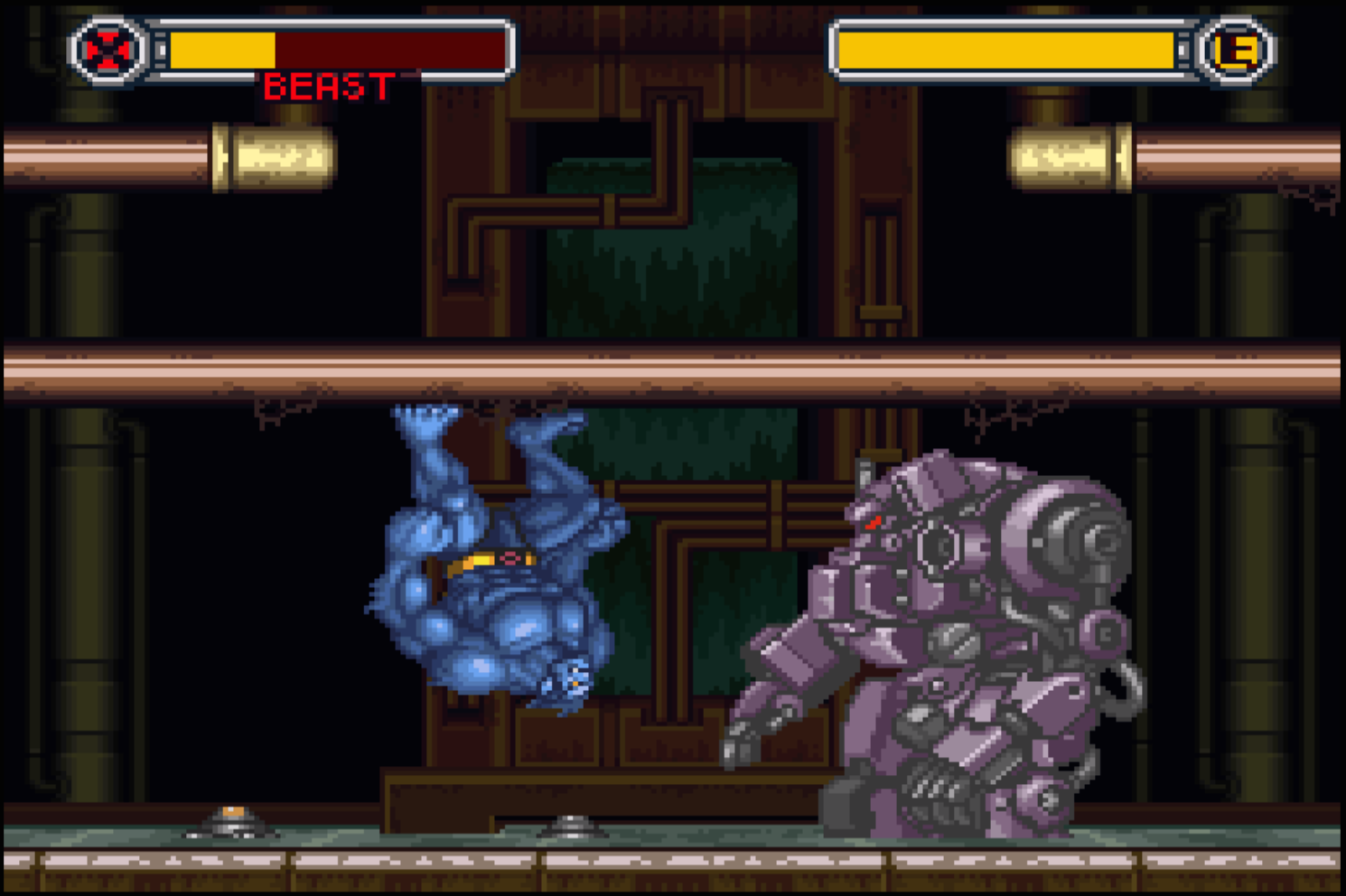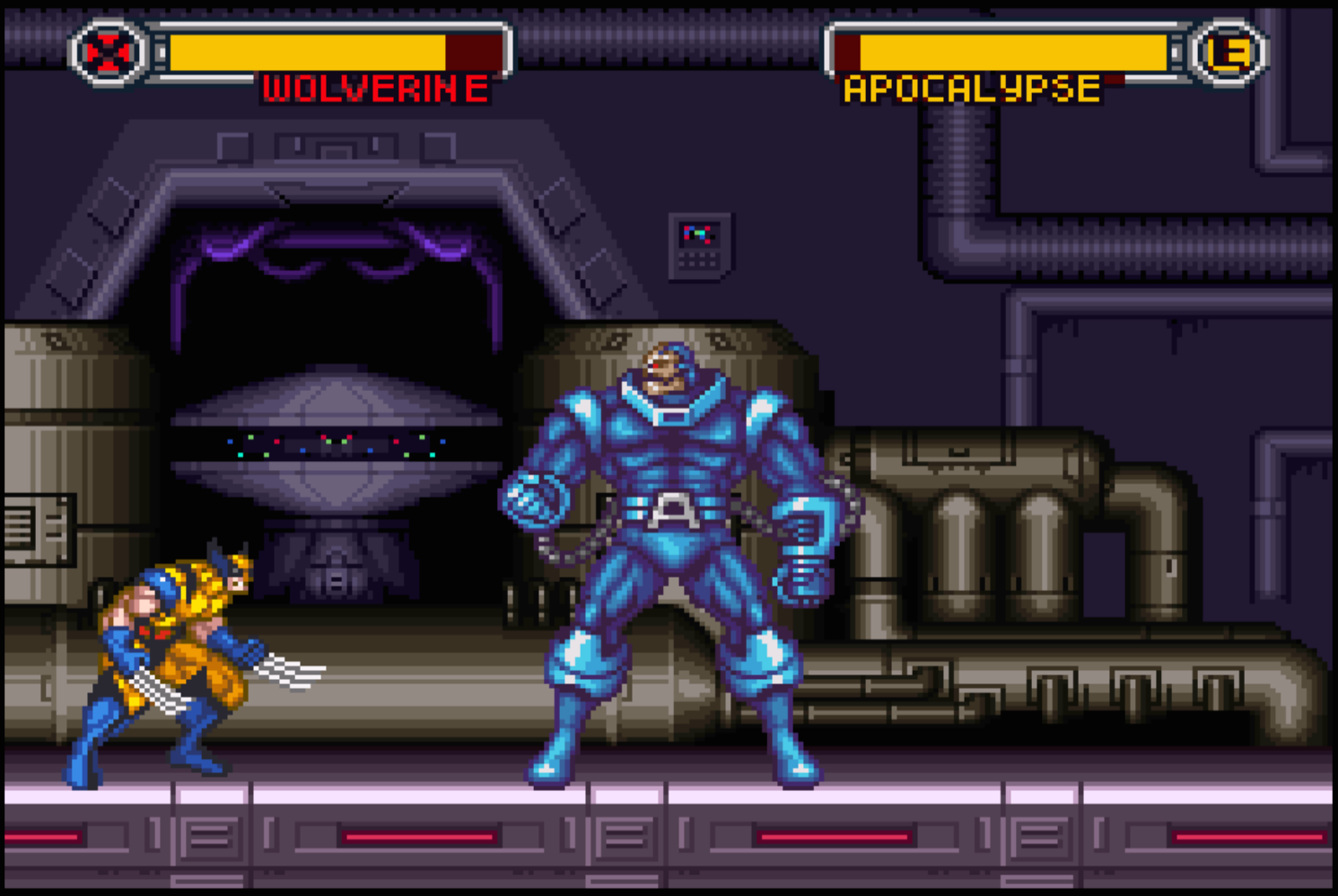X-Men: Mutant Apocalypse review
After the Fox Kids’ X-Men cartoon made the mutant superhero team extremely popular, the only decent X-Men game for home consoles was available on the Sega Genesis. For Nintendo kids like me, the wait for a good X-Men game was a longer one, but in the end, the payoff turned out to be far greater. In November 1994, Capcom released their first X-Men game on the Super Nintendo, a side-scrolling platformer/brawler titled X-Men: Mutant Apocalypse. And damn, was it good.
Tale as old as time, song as old as rhyme, Robot and the Beast.
Fresh off their arcade world domination with Street Fighter 2 and its subsequent iterations, Capcom brought a fresh take on the X-Men, focusing gameplay more on combat than platforming. Each of the game’s five playable characters—Wolverine, Cyclops, Beast, Psylocke, and Gambit—have their own beat ‘em up-style combo naturally performed by repeatedly pressing the Y button, as well as special moves that take a cue from Street Fighter’s controls. Some special attacks are performed with simple inputs, like hitting up and Y for an uppercut, or double-tapping right (or left) with Y for a lunging attack. More powerful moves are performed using motions that any Street Fighter player will be familiar with. For example, Cyclops’ optic blast and Gambit’s triple card attack utilize a quarter-circle, hadouken motion (down, down-forward, forward + Y), while Psyloke’s flying knee attack is performed like a Dragon Punch (forward, down, down-forward + Y).
A selection from the X-Men: Mutant Apocalypse instruction manual.
Capcom put no arbitrary limit on the player’s use of the X-Men’s powers, brilliantly opting instead to utilize tried-and-true input methods from their iconic fighting series to lend this game a learnable and rewarding means of mastery. By inserting a few frames recovery time into the animations of powerful special moves, the game gives you a natural motivation to not overuse specific techniques, lest you leave your character open to attack. Downside or no, you are definitely going to blast everything in sight as Cyclops and light up your enemies with Gambit’s cards. Once you get a good handle on it, the combat in Mutant Apocalypse truly shines. Controls are not quite as flawless as Street Fighter, but executing special moves is still immensely satisfying.
Everything to the right is now dead.
Of course, the similarities to a one-on-one tournament fighter were no coincidence, as Capcom would go on to release an X-Men fighting game in arcades just one month later. X-Men: Children of the Atom featured many of same heroes and villains that appeared in Mutant Apocalypse, with more detailed, highly animated sprites and fully fleshed out movesets. Gambit and Beast weren’t included in the roster, but Iceman, Storm, and Colossus filled out the good guy side, with Spiral and Silver Samurai rounding out the villain assortment. Introducing midair combos, super jumps, rolls, multi-tiered levels, and more over-the-top special attacks than players had yet seen in other fighters, the game played was like the insane mutant evolution of Street Fighter 2—which I suppose it literally was. Fun fact, Street Fighter’s Akuma (as known as Gouki) appears as a secret character in X-Men: Children of the Atom.
The story at the beginning of the X-Men: Mutant Apocalypse sees the X-Men sent on a mission to free mutants from a prison facility on the island nation Genosha. Those familiar with the X-tinction Agenda arc from the comic book will be well acquainted with Genosha, as it served as a not-at-all subtle allegory for slavery and the Apartheid. (One of my favorite X-Men tales.) This setup of course pits our heroes against an army of robotic Sentinels and mutant-hating human guards. Developments midway through the game shift the focus of the X-Men’s struggle, but it’s rather inconsequential as the plot is far less important than the execution.
As an obsessive Gambit fan in 1994, I was extremely excited for this game’s release. Beyond the Ragin’ Cajun, it was refreshing to see Psylocke, the X-Men’s exceptionally cool, telepathic ninja, on the playable roster. As it would turn out, all five of the playable characters were very well done, each receiving gameplay elements befitting their comic book origins. Cyclops’ optic blasts feel suitably powerful, taking out enemies and blowing boulders to bits with a single hit. Beast’s feet can cling to the ceiling, allowing him to traverse corridors upside down. Wolverine’s claws are always out (finally!) and slashing your way through guards and Sentinels alike is pitch-perfect fun.
Enemies are similarly well executed. Human characters like Genoshan magistrates and Magneto’s Acolytes properly straddle the line between threatening gangs and straight up punching bags. Robotic enemies like the familiar purple and red Sentinels, or new lumbering battle mechs, fit right in with the aesthetics of the game. The Brood that appear in the second level were my least favorite enemies, not so much for the annoying sound they make when they die, but more because I never really cared for them in the comic. (Like many monsters of the era, they just appear to be blatant copies of the Xenomorph from Alien.)
While Apocalypse is the titular antagonist of the game, several other X-Men villains make appearances for boss fights. In fact, [minor SPOILER from 20 years ago] after you defeat Apocalypse in fourth level, Magneto takes over as the game’s ultimate villain. Thanks to Capcom’s emphasis on combat, the many boss fights included feel well suited to the game. Going up against the likes of Apocalypse, the Juggernaut, and Omega Red is rather satisfying, but not all the boss fights are winners. Magneto’s top Acolyte, Exodus, for example, is just a cheap bastard. Unfortunately, there are three levels in Mutant Apocalypse that are nothing more than boss fights. This aspect of the game only serves to make it feel shorter than it actually is.
Speaking of the game’s length, the first level is actually five separate levels, with a different stage for each X-Man. These are really the best levels in the game, with each one uniquely constructed to highlight the abilities of that designated character. Wolverine’s first level includes platforming segments that require climbing the walls using his claws. Beast’s first level takes him through a sewer where the utility of his ability to walk on the ceiling is emphasized. And Psylocke’s first level—definitely the most difficult of the five—throws guards and robots and collapsing floors at you just to see if you can be as badass as Psylocke is meant to be.
The final level, an assault on Magneto’s space station, Avalon, again splits up each X-Man on their own unique stages. Unlike the opening levels, these Avalon stages feel short and for the most part, they don’t do much to capitalize on each character’s unique abilities. What’s more, these stages force you to fight Exodus—the cheapest boss in the game—midway through the level, before then ending with another boss fight. While none of these stages are crushing difficult, they are significantly less fun than their counterparts at the beginning.
Claw-climbing the walls. So satisfying...
Each level (that isn’t just a boss fight) contains silver emblems marked with an “X” hidden throughout. Collecting three of these “X-plates” in a level will earn you a 1-up. This gives the player more impetus to thoroughly explore the environment, which can be especially fun with Wolverine or Beast. Lost health can be recovered by picking up red health canisters (also marked with an “X”). Health canisters are sometimes just lying about, and can often be found by destroying interactive objects in the foreground. If it blows up, there’s a good chance there might be some health behind there.
Like other Capcom games of the time, Mutant Apocalypse did not include battery-backed memory to record game progress. Instead, a password system was used. Upon completing a level, the game will show you a password in the form of a sequence of eight X-Men character’s portraits. Back in the day, I used to record these in the “X-Men Notes” section of the game’s instruction manual so that I could come X-back to my X-place X-later.
Visually, X-Men: Mutant Apocalypse looks great. Considering the age of these pixels, the strong 16-bit visuals remain surprisingly appealing today. Detailed backgrounds and expressive sprites bring the 90’s X-Men aesthetic to life. The brightly colored characters look fantastic in motion, with combos and special moves flowing with the action.
Thanks to the capabilities of the SNES, the sound quality in Mutant Apocalypse is outstanding. The music is absolutely excellent, varying in intensity to appropriately match the mood of gameplay. Jazzy downbeat tracks build the suspense for sneaky infiltration segments, while the alarm-wailing action scenes are accompanied by adamantium-slashing rock. If you’ve played any of the Mega Man X titles, these rocking tracks will probably sound stylistically similar.
After envying our Sega Genesis-owning friends for over a year, the Nintendo kids finally got our X-Men game in 1994, and what a game it was! With higher quality visuals and sound than its Genesis counterpart, more refined combat-focused action, far superior level design, a stronger lineup of playable characters, and the unlimited use the X-Men’s powers, this game blew away everything that had come before it. X-Men: Mutant Apocalypse was not only well worth the wait, it set the new standard by which all future X-Men games should be judged.











